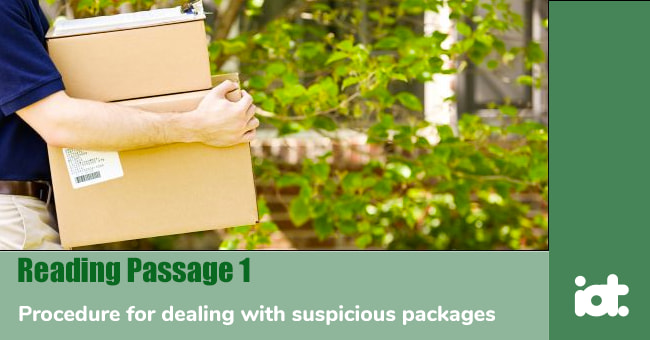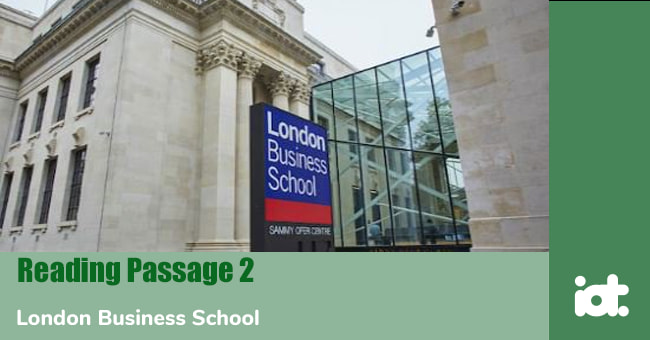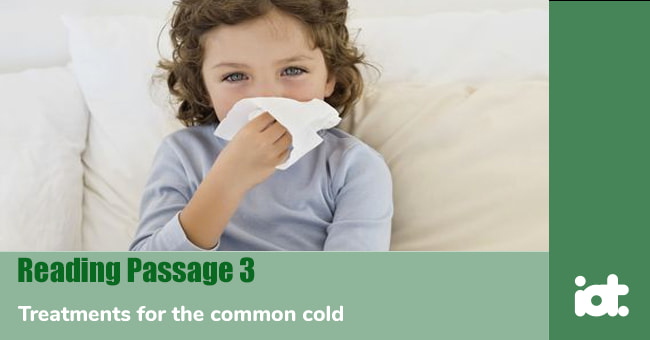Part 1
READING PASSAGE 1
Read the text below and answer Questions 1-14.

PROCEDURE FOR DEALING WITH A SUSPICIOUS PACKAGE
There are three procedures for dealing with a suspicious object such as a bag, briefcase, backpack, package, mail, box, depending on the situation. A. If it is suspected that the item is an explosive device:1. Phone Security (ring 4444) and Mail Room (ring 7771 or 7772). 2. Evacuate the area. B. If the suspicious object has not been opened:1. Put gloves on your hands, if possible. 2. Place it in a plastic bag and seal it. Handle with care. 3. Do not leave your office or immediate work area. 4. No personnel working in the same space should be allowed to leave room. 5. Take measures to prevent others from entering the area because there is a risk of potential contamination. 6. Phone Security (ring 4444) and Mail Room (ring 7771 or 7772). 7. Give Security the following information: a. exact location of the suspicious object (building, floor level, room number) b. number of people potentially contaminated c. description of the suspicious object d. details of action taken (e.g. object sealed and area isolated). 8. Do not touch your face to avoid contaminating your eyes, nose and mouth. 9. Wash your hands only if it is possible to do so without leaving your work area. 10. Wait for help to arrive patiently and do not panic. It is unlikely you will be In any immediate danger. C. If the suspicious object has been opened:1. Put gloves on your hands, if possible. 2. Place all items in a second plastic bag and seal that bag. Handle Items carefully. 3. Do not disturb the object and items further and do not pass them around. 4. If any material has split from the object, do not attempt to clean it up or brush it away from your clothing. 5. Cover the object with a large dustbin (or something similar) without disturbing it further. 6. Follow steps 3 to 9 above. 7. Shut down the building ventilation system and turn off fans or any equipment circulating air around your office or building. 8. Wait for help to arrive patiently and do not panic. It is unlikely you will be in any immediate danger. |
Read the text below and answer Questions 10-14.
The course consists of three modules as described below: Module 1: Business Basics- an introduction to the world of business, including an understanding of markets and market economies - an understanding of the structures, cultures and functioning of business organisations - an understanding of the complex nature of key business functions and processes - an understanding of the processes and outcomes of organisational decision-making, that is, how organisational strategies both develop and diversify as well as the nature and role of policies which impact on business - a range of important business graduate skills, which you can apply to your work directly Module 2: Business Advanced 1This is an advanced course focusing on social impact management. In other words, you will study concepts and insights which are absolutely necessary for success in contemporary business management, where public pressure for corporations to address pressing social and environmental concerns is increasingly apparent. Module 2 prepares you to face precisely those challenges. Module 3: Business Advanced 2Module 3 is a course that puts theory into practice, giving you the skills and knowledge to apply what you learn in your workplace, industry and career. Our programmers are developed with insights from leading industry experts and courses are taught by respected faculty who are active practitioners in the field of Business and Management. For more information on our business and management programmes, tuition fees, financial aid and scholarships, download our brochure or call one of our admissions tutors. |
Part 2
READING PASSAGE 2
Read the text below and answer Questions 15-28.

A London Business School Training and Development College caters for the training needs of central London businesses. Irrespective of what the needs of the business or organisation might be, our college can provide high-quality, short-term customised training for business, industry and government organisations as well as for the general public. B London Business School Training and Development College faculty boasts several highly qualified trainers and coordinators with relevant and up-to-date business experiences. In addition, Training and Development also work with our Business School faculty, part-time industry leaders and external agencies to deliver quality training tailored to meet the needs of any business, schedules or location. C Whether your company is focused on manufacturing, construction, agriculture, retail or service, Training and Development College can help develop and enhance the skills of your employees. D We also collaborate with many other London colleges to deliver training not only across London but also throughout Greater London as well as in most of the towns surrounding the Greater London area. E We also provide instruction and assistance in writing Job Training grants requests. In fact, our Worker Training programme is a business incentive programme designed to support the retraining and upgrading of London's current workforce. F Should you be interested in finding out more about our training programmes and/or upgrading the skill level of your employees, we should appreciate the opportunity to inform you. We would be glad to schedule an appointment for you with one of our advisors during which we can find out more about your company or organization and discuss the best way to serve your needs. G For information about Training and Development classes on our London Campus please contact Dr. Brian Richardson. Brian Richardson, PhD Dean of School of Extended Learning Services and Training London brianrichardson@lbs_t&d |
Read the text below and answer Questions 22-28.
There are many different kinds of dismissal including sacking, redundancy, unfair dismissal, wrongful dismissal and constructive dismissal. A dismissal is a redundancy when you terminate an employee's contract because there is a requirement to lose a particular number of employees, or when a fixed-term contract of two years or more expires and is not renewed. A dismissal is a sacking when you terminate an employee's contract because of their conduct or capability. Examples of minor misconduct include being late, using company phones for personal calls, using company facilities for personal reasons, not performing to adequate/satisfactory standards, etc. Examples of gross misconduct include abusive behaviour, violence, theft, fraud, alcohol or drug abuse, discrimination or harassment, deliberately damaging company equipment/property, seriously breaking health and safety regulations and serious insubordination, amongst other things. Whatever the grounds for dismissal, the employer must follow the correct dismissal procedure, otherwise the dismissal will be considered either an unfair or a wrongful dismissal. The correct dismissal procedure involves the following five steps: a. establishing the facts of the case b. informing the employee of the problem c. holding a meeting with the employee to discuss the problem d. deciding on appropriate action e. providing employees with an opportunity to appeal A dismissal is an unfair dismissal when an employer terminates an employee's contract for a reason which is considered unfair by law or if the employer acts unreasonably during the dismissal process. There are many different reasons why a dismissal would be considered automatically unfair. One such example is dismissal on grounds of race, gender or disability. It must be pointed out, however, that it is not wrong to dismiss a disabled person as long as the grounds for dismissal are unrelated to the disability. Indeed, to dismiss a disabled person for serious negligence is quite reasonable, but to dismiss them for slow productivity caused by their disability is not allowed. This is always the case, no matter when the disability became apparent/occurred. The situation becomes more complex if the disability in question makes the employee unable to carry out their existing job at all. In this case, the employer should look to provide alternative work. A wrongful dismissal is when you do not follow the correct dismissal procedure or break contractual terms during the dismissal process. One example is dismissing an employee before the time specified in their contract as the end of their contract. Constructive dismissal occurs when an employee resigns because the employer has breached their employment contract substantially. Examples of constructive dismissal would be resignation due to the employer cutting an employee's wages without agreement, or resignation due to the employer unlawfully demoting the employee. A constructive dismissal is not necessarily an unfair dismissal, although it would be difficult for an employer to show that an action in breach of the contract was, in fact, fair. |
Part 3
READING PASSAGE 3
Read the text below and answer Questions 29-40.

Treatments for the common cold
Colds, we all get them. Adults typically have two to four colds a year and children about double that.
Throughout the ages, many treatments have been tried for the common cold. These include bizarre cures, such as wearing wet socks, putting brown paper and vinegar on your chest and soaking your feet in hot water, which today of course seem stupid. Nevertheless, even modern treatments for colds are not particularly effective. Generally, they only reduce the symptoms: blocked or runny nose, sneezing, sore throat, coughing rather than treating the viral infection itself.
One area of treatment and prevention for colds is diet. It is particularly important to eat healthily to reinforce your body's capacity to deal with viral infections: a low-fat, high-fibre diet, which includes plenty of fresh fruit and vegetables. It's also recommended to drink plenty of fluids to replace those lost due to sweating and a runny nose.
It is commonly believed that supplementing your diet with vitamins C and D is also a good idea. However, the evidence suggests that the benefits of these are modest. Taking vitamin C has been shown to help people under great physical strain, such as marathon runners, from falling ill, but for the rest of us it only reduces your risk by 3%. This means that if you get three colds a year, vitamin C supplements will only enable you to avoid one cold in 10 years.
More effective are zinc supplements. Taking zinc syrup, tablets or lozenges within a day of the symptoms starting will speed up recovery and lessen the severity of symptoms, by a day or so. Clinical trials show that children taking regular zinc supplements will suffer roughly 1 to 1.5 fewer colds a year on average - compared to the six to eight that is normal for school children. However, long-term use of zinc can be problematic as it could cause side effects such as vomiting and diarrhoea. The consumption of alcohol is sometimes said to make you more vulnerable to colds. However, recent studies suggest that regular but moderate drinkers are in fact less likely to catch a cold. This is particularly the case if you drink wine.
Many people take medication when they have a cold. Over-the-counter pills typically combine painkillers and decongestants. Painkillers, such as ibuprofen, paracetamol and aspirin, can help reduce fever as well as pain. Decongestants, such as pseudoephedrine, can be taken by mouth or as a spray in your nose and are designed to reduce nasal congestion. However, the benefits of these medicines are often modest and vary between people, and with the particular types of infection. Nevertheless, these over-the-counter cold medicines are probably the most widely used type of medication.
One word of warning about medication - do not even think of taking antibiotics. There is, quite simply, no reason why antibiotics should help, since they target bacteria whereas it is viruses that cause colds.
Another oft-used treatment are herbal remedies, such as Echinacea and garlic tablets, but these do not have any effect. The only herbal remedy to show any beneficial results in tests is honey. These indicate that a spoonful, taken straight before bed, can soothe a cough and has a better success rate than other sugary drinks and cough syrups. However, further studies are required.
Other remedies that seem to have some impact include steam inhalation, which involves putting a towel over your head and sitting with your head over a bowl of hot water. You simply close your eyes and breathe deeply. Gargling with salt water sometimes reduces a sore throat and nasal congestion and menthol sweets can also help relieve a sore throat.
One thing that people tend to forget about is the psychological support you receive from the people around you. With a high level of support, people tend to get over their illness more quickly. For example, studies show that patients who report feeling greater empathy from their doctor recover faster, both in terms of their symptoms disappearing and in measures of their immune activity.
Finally, though, it is worth pointing out that perhaps the most effective treatment for a cold is taking measures to avoid getting one in the first place. And much of this is commonsensical: wash your hands regularly and properly, particularly after touching your nose or mouth and before handling food; clean surfaces regularly to keep them free of germs; use your own cup, plates and cutlery and use disposable paper towels to dry your hands and face rather than shared cloth towels. Other measures, like opening the window on a crowded bus, may also be effective, but are not to everyone's taste.
Part 1
Questions 1-9
Complete the sentences below.
Choose NO MORE THAN THREE WORDS from the text for each answer.
PROCEDURE FOR DEALING WITH A SUSPICIOUS PACKAGE
If you believe the item is a bomb, call Security and Mail Room and 1
If the suspicious mail or package has not been opened, you should put it in a plastic bag and 2
Whether the package has been opened or not, you should stay in your office or immediate 3
You must prevent all people from leaving or entering the area and causing 4
You should advise Security of the 5 of the incident.
It is important to keep your hands away from your 6 contamination.
There is no reason to be overly concerned because there is probably no 7
Do not allow anyone to handle the object and items or 8
If any 9 from the item, place an object over it without disturbing it (such as a waste bin).
Questions 10-14
Do the following statements agree with the information given in the text?
For questions 10-14, write
| TRUE. | if the statement agrees with the information | |
| FALSE. | if the statement contradicts the information | |
| NOT GIVEN. | If there is no information on this |
10. If you do the course, you will gain knowledge critical to success in today’s business world.
11. In today’s business world, large businesses often find themselves increasingly in a position where they have to take a stand on serious ecological issues.
12. The brochure includes information about on-campus accommodation.
13. The course is entirely theoretical and does not offer work experience.
14. There are special scholarships for university graduates.
Part 2
Questions 15-21
The text has seven paragraphs, A-G.
Which paragraph contains the following information?
Write the correct letter, A-G, next to questions 15-21.
15. locations where training is available
16. applying for funding
17. calibre of training staff
18. how to contact us
19. arranging a visit
20. what is offered and by whom
21. examples of fields of business dealt with
Questions 22-28
Look at the following descriptions and the list of terms in the box below.
Match each description with the correct term, A-G.
Write the appropriate letter, A-G, next to questions 22-28.
| List of Terms | ||
| A. | sacking | |
| B. | redundancy | |
| C. | infair dismissal | |
| D. | wrongful dismissal | |
| E. | constructive dismissal | |
| F. | minor misconduct | |
| G. | gross misconduct | |
List of Descriptions
22. The closure of the department meant that over 100 people lost their jobs because they were no longer needed.
23. An employee is using a company vehicle for unauthorised personal use.
24. An employee is fired for misusing the Internet at work.
25. An employee is making sexual remarks to someone from work who does not want this sort of attention
26. The resignation of an employee as a result of the employer allowing colleagues to subject them to harassment, bullying, victimisation, humiliation or discrimination.
27. An employee is dismissed because of trade union membership
28. An employee is dismissed without being given proper notice
Part 3
Questions 29-35
Complete the summary below.
Choose NO MORE THAN TWO WORDS from the text for each answer.
Neither ancient nor modern treatments for the common cold are particularly effective. In general, most treatments merely ease the symptoms but they are not very efficacious when it comes to treating the 29 that is the cause of the symptoms. Taking vitamin C supplements is not as beneficial as some people might think unless you are a professional athlete under great 30 . Zinc supplements are much more effective but they have 31 Strangely enough, moderate consumption of wine can make it 32 to catch a cold. Over-the-counter cold medicines are very popular, despite the fact that their benefits are 33 . However, remedies, such as steam inhalation, gargling with salt water and menthol sweets, appear to have 34 But the best treatment of all is prevention. The precautions you need to take include such simple measures as washing your hands regularly and making sure you dry them on 35 kitchen roll or something equivalent rather than a used facecloth. |
Questions 36-40
Choose the correct letter, A, B, C or D.


